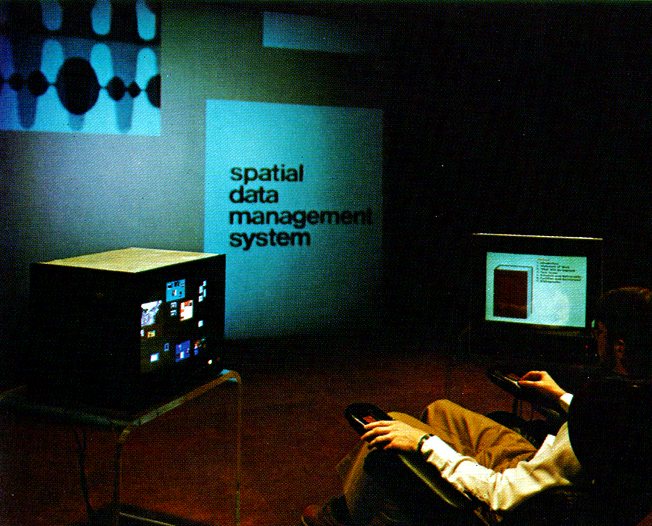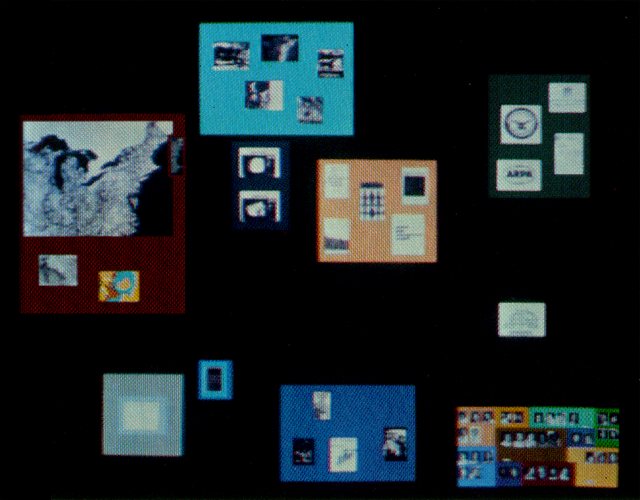While Xerox PARC is located in California the Architecture Machine Group was working at MIT in Massachusetts. It was formed in 1967 by Nicholas Negroponte and got financial support from the Cybernetics Technology Office (CTO), another division at DARPA.
In the mid-1960s Negroponte was a student of architecture. His dream was to have a machine to support the creative design process of architects. He was convinced, that for such a device to be truly helpful, it would have to be intensely interactive with the human user, The Media Lab: Inventing the Future at M.I.T. [Brand 87, p. 137]. This explains the heritage of the name of the Architecture Machine Group, and also the devotion for human-computer interaction.
Throughout the 1970s, the Architecture Machine Group explored chances of a computer-based medium. The Aspen Movie Map for example is a video disk application, that offers a virtual tour through the city of Aspen, Colorado. The user is free to move in any direction and even to change the season at any point of the session [Nielsen 95, p. 40]. Other projects use speech or holographic images. But especially Richard Bolt’s work on the Spatial Data Management System (cf. 3.1.7) is of interest for the history of graphical user interfaces. One of SDMS’s components is called Dataland. It is the projection of data to a two-dimensional field. The user can move and zoom into the Dataland to enlarge thumbnails of documents until the content becomes accessible.
3.1.7 Spatial Data Management System
in Vision and Reality of Hypertext and Graphical User Interfaces
According to Nicholas Negroponte and Richard Bolt, the Spatial Data Management System (SDMS) was motivated by two ideas [Brand 87, p. 138]. First is the psychological notion of motor-memory reinforcement. For instance, to overcome the uncertainty whether one has locked a door or not, one can remember the cold perception and the weight of the key in ones hand. To find a book one can remember the raised and stretched out left arm, that was used to put the book on the top of a shelf. A final example to illustrate the importance of physical involvement is about two scientists, arguing a topic in front of a blackboard. They «will refer each other to diagrams, equations, and terms on the basis of where they had been written, even long after they have been erased» [Ibid.].
The second idea is inspired by the ancient Greek poet Simonides of Ceos. Simonides should have been famous for his ability to recite epic poems entirely from memory.* * Simonides has a name as the founder of mnemotechnics, the art of memory. In Informations- und Wissensorganisation anhand räumlicher Ordnungsmodelle: Das Spatial Data-Management System der Architecture Machine Group als Fallbeispiel Kirsten Wagner argues, that mnemotechnics has first been applied to computer science by Negroponte and Bolt [Wagner 2000]. Mnemotechnics is named after Mnemosyne, the personifocation of memory in Greek mythology. Negroponte and Bolt explain how he managed to remember such long tales without making any mistakes [Ibid.]:
His secret was to tie each successive part of a to-be-remembered poem or speak to a specific locale within the mental floor plan of either an actual or imagined temple. … For each successive subsection of the talk to be given, the orator would mentally walk from place to place within the temple, rehearing the appropriate material before some specific piece of statuary.
The psychological explanation to this phenomenon is, that humans learn without effort about the relationships of objects in space. Simonides employed this quality to attach names, things, and even abstract ideas to spots of his mental temple.
The first motivating idea reflects on our physical interaction with the world, while the latter accentuates our mental preference for spacial relations. With SDMS Bolt and Negroponte devise a human-computer interface that takes into consideration both aspects. Objects like books, letters, and telephones are spatially arranged in a 2-dimensional Dataland. The positions are persistent in order to allow humans to become used to them.

Fig. 3.10 The Media Room of the MIT Spacial Data Management System, around 1977. The user sits in a comfortable armchair with an integrated joystick and touch-sensitive pad. Two monitors and a wall-size projection screen are used as displays.
Most exceptional is SDMS’ working environment. The user sits in the center of the Media Room (cf. Fig. 3.10). Two small monitors are set up front left, respectively front right. Between them opens the view to a wall-size projection screen. The left monitor always contains an overview of the Dataland (cf. Fig. 3.11).

Fig. 3.11 The Dataland of the MIT Spacial Data Management System. The light translucent overlay (bottom left) represents the section that is currently displayed on the main screen.
The user can point with a finger to the touch sensitive screen, or navigate with a joystick over the Dataland to define a section that should be blown up for the main projection screen. In The Human Interface: Where People and Computers Meet [Bolt 84, p. 12] Richard Bolt points out, that
[…] the items in Dataland are facsimile in nature: books look like books, calendars like calendars, and so on. Dataland is not a map of the data. It is the data.
SDMS does not distinguish between icons and document windows, like Xerox Star will do a few years later. The user can zoom into the minimized thumbnail world of material until an item becomes clear and legible. The monitor to the right will display control elements to edit the document in focus. For example, if the main screen displays a calculator in full-size the secondary monitor offers numerical and mathematical function buttons. If the user zooms in a book, the monitor will display the table of contents. The book can be read on the main screen. To turn a page the user has to perform a diagonal top-right to bottom-left finger stroke on the touch-sensitive pad, that is built into the arm rest. The turning of the page is accompanied by a page-flipping animation. Richard Bolt argues [Ibid., p. 15],
[…] This page-turning animation visually separates one page from the next and gives readers a sense of where they are in the material in a way that endlessly scrolled text would not.
On long jumps that are directly issued at the table of contents, the animation takes longer to indicate more skipped pages. This artificial delay – computers could do it almost instantaneously – is the equivalent to the physical steps of opening a book on a specific page. It helps to later recall the position of a paragraph of interest.
Later versions of SDMS and military implementations introduce a hierarchy of Datalands. A new item called port connects Datalands with each other. If the user focusses on a port and continues to zoom in the Dataland of the next level unfolds.
It shall also be mentioned, that the Architecture Machine Group did research on the field of multi-modal input. A third methods of navigation in SDMS is «voice travel». For example, the spoken words “Take me to the calculator.” would focus the main screen accordingly [Ibid., p. 13]. The project Put-That-There of 1980 utilizes speech recognition and pointing gestures to move items in Dataland [Bolt 84, pp. 35].
![]() For a free PDF version of Vision and Reality of Hypertext and Graphical User Interfaces (122 pages), send an e-mail to:
For a free PDF version of Vision and Reality of Hypertext and Graphical User Interfaces (122 pages), send an e-mail to:
![]() mprove@acm.org I’ll usually respond within a day. [privacy policy]
mprove@acm.org I’ll usually respond within a day. [privacy policy]